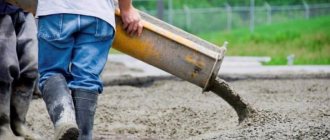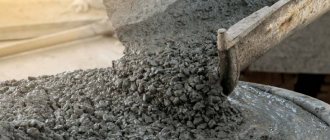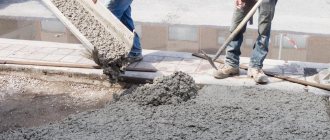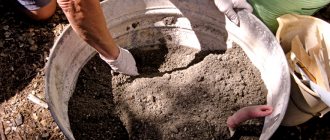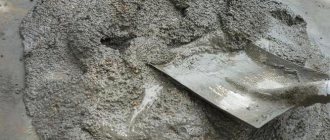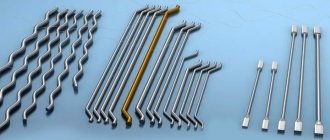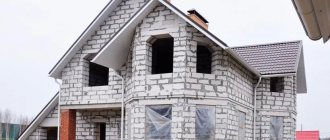Expanded clay concrete is an analogue of concrete mortar used for floor screed. Only in the composition of the building material, instead of fine crushed stone, expanded clay granules are used, the result is a warm floor base. By observing the proportions for expanded clay concrete established by building codes, you can prepare it yourself. But expanded clay concrete is a fragile building material, so it is not used for leveling surfaces that will subsequently be subject to constant loads.
The material is a composite with a porous structure used in construction.
Equipment preparation
To produce the material, the master will need a concrete mixer and a vibrating machine.
Manual vibration machines
The small-sized device is optimal for carrying out work in non-professional conditions.
Main characteristics:
- the vibrator is fixed on the body and produces moderate vibrations, which ensures uniform distribution of the working mass over the shape;
- The product is equipped with stationary and removable void formers. In the first case, solid and hollow modules can be produced;
- depending on the manufacturer and additional options, the cost of the vibrator reaches 10 thousand rubles.
The use of special equipment will ensure high quality of the finished block, but may be expensive for private construction
Mechanized mobile machines
Main characteristics:
- the equipment is equipped with a supporting body and a lever drive for automatic removal of the mold from the body;
- the machine is equipped with wheels that allow easy movement around the site;
- depending on your needs, you can choose a model with various add-ons, for example, a compacting press;
- the vibrator is fixed on the device and sends an impulse to the form;
- the device can be equipped with 4 matrices, which speeds up the production process;
- the cost reaches 16 thousand rubles
Vibrating table
Main characteristics:
- the base of the device is equipped with a built-in vibrator; a metal tray up to 3 mm thick is placed here;
- Forms are placed on a pallet and compacted by vibrations;
- then the pallet is taken to a ventilated, dry place where the material finally dries;
- all manipulations are carried out manually;
- You can prepare up to 6 forms at a time, which are conveniently transported on a pallet to the drying place;
- the lower placement of vibrators allows you to obtain a complete and optimal distribution of vibrations throughout the table;
- the cost of equipment fluctuates around 20 tr;
- The vibrating table is not mobile, large in size and requires a lot of manual labor.
Vibropress
Equipment of this class is used in large factories and enterprises. At all stages of block production, manual labor is practically eliminated. The device is characterized by high performance and allows you to obtain excellent quality modules.
A concrete mixer with a volume of at least 130 liters is used to mix the mixture.
Monolith made of lightweight expanded clay concrete
xanchez FORUMHOUSE Member
My wife and I are builders by training, thanks to which the sold “kopeck piece” did not sink into oblivion without a response, and my small carpentry workshop largely set the “style” of the then future house - a lot of wood (windows, ceilings, floors, stairs), Almost everything is made from larch. There wasn't much money, but the end result seemed to work out well.
A project published in one of the specialized magazines was taken as a basis; during the adjustment process, it underwent minor changes.
The foundation of TISE is bored piles with a diameter of 250 mm, at a depth of 1.7 meters the base expands to 600 mm, since the foundation “walks” by an average of 5 cm, the blind area is made sliding, with a minimum gap. The thickness of the walls is 400 mm, the thickness of the partitions is 120 mm.
Preparing forms
You can make your own molds using a simple 20 mm wooden board. The design is formed on the basis of a pallet and two L-shaped elements, which, when assembled, form sides or 4 standard sides.
The product can be intended for the manufacture of hollow or solid modules:
- forms without voids;
- forms with through voids;
- forms with blind voids.
The product parameters must ensure the production of the required dimensions of the expanded clay concrete block. The inside of the mold is lined with metal. An alternative would be to make the molds entirely from metal. This will ensure that the finished block comes off easily.
Brief analysis of the profitability of the issue
Unfortunately, it is not possible to calculate a universal business plan, since the profitability of production depends on many factors, the main of which are:
- Cost of investment;
- Region of doing business, purchasing power in it;
- Cost of raw materials;
- Household expenses, quantity of defects and much more.
Of course, it is possible to roughly calculate the economic feasibility. Let’s assume that, as statistics state, the cost of a cube of expanded clay concrete block will be 2,300 rubles.
- The equipment will cost, for factory production, 5,000,000 (budget version of a conveyor line).
- The average market value for sale is 3,500 rubles per m3 of products.
- Let us assume that the daily production volume is 50 m3. Monthly, in this case, with daily work is equal to 1500 m3.
- Income from the sale of all products will amount to 5,250,000.
- Net income: 2300*1500=3450000. 5250000-3450000=1800000
- Payback: 5000000\1800000=2.7 months. This, of course, is an extremely optimistic scenario, but still realistic.
- In the case of home production for your own use, the calculations look even simpler.
- Let's assume that we need 150m3 of products.
- Cost price – 2500, market value – 3500 rubles per m3.
- The cost of the equipment is about 60,000.
We count: 3500-2500=1000. 1000*150=150000.
15000-60000=90000 – this is our benefit.
Expanded clay concrete - composition
Below are several recipes that can be used to prepare the working mixture.
Recommended composition of 1 m³ of concrete for the manufacture of wall stones:
- Portland cement M400 – 230 kg;
- expanded clay gravel, fraction 5.0-10.0 mm, density 700-800 mg/m³ – 600-760 kg;
- quartz sand, 2.0-2.5 mm – 600 kg;
- water – 190 kg.
If you use the specified recipe, you can obtain concrete grade M150, with a volumetric mass of dry concrete of 1430-1590 kg/m³.
To increase the resistance of expanded clay concrete to water, some aggressive environments and freezing, you can use the following recipe per 1 m3:
- cement – 250 kg;
- expanded clay mixture – 460 kg;
- expanded clay sand – 277 kg;
- W/C – the ratio of cement and water – is taken as 0.9;
- Bitumen emulsion – 10% of the volume of mixing water.
Before work, the bottom of the mold is sprinkled with sand, the sides are treated with machine oil.
How to prepare expanded clay concrete with your own hands per 100 kg of working mixture:
- expanded clay – 54.5 kg;
- sand – 27.2 kg;
- cement – 9.21;
- water – 9.09 kg.
From the specified number of components, 9-10 hollow modules can be made.
How to make expanded clay concrete without a dispenser? If we take a bucket as a volumetric unit, it is permissible to use the indicated proportions:
- cement M400 – 1 unit;
- purified sand, 5 mm – 2 units;
- expanded clay, density 350-500 kg/m³ – 8 units;
- water – 1.5 units. – the final liquid content is determined on site, depending on the consistency of the resulting solution.
Stages of work execution
Before preparing the mixture, you need to prepare a mold for making expanded clay concrete blocks. The work is carried out in 4 stages:
- Mix the prepared ingredients. Take a responsible approach to maintaining their proportions. The third part of the volume of the mixture will be sand, to which you need to add 1 part of water. The same amount of cement M400, M500 will be required. Expanded clay is used in 6 parts.
In order not to be mistaken in the calculations, you need to know that a 10 liter bucket contains up to 5–6 kg of expanded clay with a fraction of 5–20 mm. At 1 m? the mixture needs 300–400 kg of expanded clay. It depends on what block density you want to achieve. Manufacturing technology requires a strict sequence of mixing ingredients. If you use a concrete mixer, water is poured out first, then expanded clay, cement and sand are added.
- Mix the mixture well and begin shaping the building material. If KBBs are manufactured in production, then vibrating machines are used to compact the solution. But for our case, such equipment is not available, so at home we use special forms or formwork. When the mixture begins to harden and flow out, the expanded clay needs to be compacted with a shovel to avoid unevenness during laying of the KBB. After a day, the solution will “set” and the L-shaped structures can be split. Laying of blocks begins no earlier than 7–10 days after removal from the formwork.
At home, you can use a vibrating table, which will facilitate the process of making KBB. A steel plate is placed in the mold for expanded clay blocks, and only then it is filled with the building mixture. After turning on the engine, when the material vibrates, it may leak out. Therefore, it can be easily removed with a special tool.
- When the block is formed, it is lifted using a plate from the vibrating table.
- Two days are enough to dry the expanded clay concrete made by yourself.
You can get a strong, light, effective mixture if you follow the correct technology for mixing all components.
The manufactured blocks can be compared to ordinary ceramic bricks, since they are made from purely environmentally friendly natural materials. Using blocks, the owner saves 25–30% of money. The size of one block is equal to 7 bricks, which allows you to speed up the construction process.
Preparing the mixture
How to make expanded clay concrete, the proportions of which are selected and ready for mixing? For work, a forced mixing mixer is used, which does not allow changes in the granulometric composition of expanded clay grains and their destruction.
The duration of the batch depends on the vibratory ability of the solution and is 3-6 minutes . Due to the fact that expanded clay concrete quickly loses its workability, it is permissible to keep it in the mold after preparation until compaction for no more than 30 seconds.
The sequence of placing components into a concrete mixer:
- water;
- plasticizer – if used;
- sand, after which the mass is thoroughly mixed;
- the entire volume of expanded clay is gradually introduced;
- cement.
When mixing, the gravel should be covered with cement mortar. The mass should be homogeneous.
It is convenient to dose the material using volumetric dispensers, which will ensure an optimal granulometric composition.
With longer aging, the strength of expanded clay concrete can be lost, which is dangerous in the production of material intended for wall structures
What does expanded clay block consist of?
A high-quality expanded clay block consists of components that have previously passed certification. This is Portland cement of a certain brand, expanded clay fractions, fine sand dispersion, and also water are needed. In this case, Portland cement acts as a binder. All ingredients have requirements that must also be observed when making the stone yourself.
The composition of expanded clay concrete blocks is described in this video:
Binding components
Portland cement is used as a binding ingredient . For expanded clay blocks, it must have certain characteristics and comply with GOST 10178-85:
- brand not lower than M400;
- cement may be without additives or may have mineral additives;
- the tensile strength of cement in bending must be at least 5.4 (55) MPa (kgf/cm);
- the compressive strength should not be less than 39.2 (400) MPa (kgf/cm);
- The beginning of setting should occur no earlier than 45 minutes after preparation.
The more Portland cement you add to the stone, the stronger it will be. If you use low-grade material, the volumetric weight of the finished block will decrease. Because of this, it is recommended to use Portland cement of a grade no lower than M400.
Water
Requirements for the quality of water for the solution are agreed upon in the document GOST 23732-79, which defines the standards and acceptable characteristics of the liquid for concrete.
It says here that water should not contain impurities , but if they do exist, then their amount should not exceed 10 mg/liter.
The solution water should not contain petroleum products, fats or oils. Also, there should be no coloring impurities.
It is best to use tap water at room temperature; it should not be hot or very cold. It is prohibited to use water from lakes and seas for the composition.
Also, the water must contain a certain amount of soluble salts, ions and suspended particles. Standard indicators are determined by taking a sample and conducting an examination of the liquid . The oxidation of water should not be more than 15 mg per liter.
Expanded clay and sand
Sand and expanded clay are considered fillers for expanded clay concrete stone. There are also several requirements for their quality. For example, some manufacturers use coarse or medium sand to create a good frame for the future block. It is better to use expanded clay in a small dispersion. The ideal fraction size is from 5 to 10 mm: this adds strength to the block.
Reference ! Requirements for expanded clay are determined by the standards from the document GOST 9757-90, which indicates its recommended density and weight.
How to make expanded clay concrete blocks yourself, video
The work can be carried out with or without special equipment, which affects the quality of the finished module.
If you need to make expanded clay concrete blocks with your own hands, the finished working mixture is molded:
- a stainless steel plate is placed in a special recess on the vibrating machine;
- expanded clay concrete is poured onto the plate;
- vibration densely distributes and compacts the mixture;
- the excess is removed with a trowel;
- the plate with the formed mass is moved to drying.
- drying is the final stage. The blocks, being in steel plates, dry for 48 hours. After this, the plates are removed and the process continues in the open air until they are completely ripe.
If the master does not have the appropriate equipment, there is another way to make blocks:
- the form is installed on a flat metal surface;
- the formwork is filled with mortar;
- the mixture is compacted with a wooden or metal block, but it is best to implement this process on a vibrating table;
- when the laitance is released, the top of the module is leveled with a trowel;
- The form is removed after 24-48 hours, the blocks are left until fully ripe.
Advantages of constructing buildings with expanded clay concrete
Expanded clay concrete is lightweight, which allows you to create durable housing with a fairly presentable appearance, even on a small foundation.
Expanded clay concrete is the only one of the most promising modern materials for construction. Its properties in terms of speed of construction of various objects and cost-effectiveness of use significantly exceed the qualities of other materials.
Expanded clay concrete structures are made exclusively from natural components, and for this reason they do not emit toxic substances into the environment. If you believe the reviews of those who built a house from expanded clay concrete blocks, they claim that very comfortable climatic conditions for living are established in the room.
Note. High-quality expanded clay concrete blocks have a density from 600 to 1800 kg/m3.
Expanded clay concrete, floor composition
The selection of expanded clay concrete proportions for the floor depends on the operational load of the coating. If you intend to install floors for domestic purposes, it is advisable to use the following recipe:
- cement M500 – 263 kg;
- water – 186 l;
- sand – 1068 kg;
- expanded clay – 0.9 m³.
To prepare the working mass, a standard concrete mixer is used. It is difficult to achieve homogeneity of the working mass by manual mixing
For expanded clay concrete, the proportions for the screed may vary. The following recipe is considered no less effective:
- cement-sand mixture – 60 kg;
- expanded clay – 50 kg.
To prepare a cement-sand mixture, the ratio of components is taken as 1:3, for example, for 45 kg of sand you will need 15 kg of cement.
The proportions of expanded clay concrete for the floor allow you to choose the brand strength of the material. The following are the proportions regarding the content of expanded clay, sand, and cement:
- 7/3.5/1.0 – M150;
- 7/1.9/1.0 – M300;
- 7/1.2/1.0 – M400.
Proportions, mortar preparation technology, formwork, pouring
Cement without sand is prone to the formation of microcracks; excess sand weakens the solution. As a result of experimenting with proportions, xanchez selected the optimal ratio of components for its purposes.
- Cement – 1 part.
- Sand – 1 part.
- Expanded clay fraction 10-20 mm - from 10 to 12 parts.
An ordinary concrete mixer, for about 80 liters of expanded clay, the optimal angle of inclination of the rotation axis is about 45⁰, expanded clay is poured in first, sand and cement are added during rotation, and water immediately. The craftsman determined its quantity “by eye.”
xanchez
It is important to choose the right amount of water; the expanded clay in the mix should be “glazed” with cement-sand milk, but water should not leave it. After the first kneading, I noted the amount of water and added the same amount, only if there was precipitation, I adjusted it. I didn’t add any PVA, liquid soap or ready-made chemicals, how many years has it been standing, no cracks.
The mixing cycle is 10-15 minutes, the readiness of the solution can be determined by its color - initially it is red, like expanded clay, but gradually turns gray. As soon as the red markings are no longer visible, the solution is ready. Since the full mixer did not start well, it was not stopped between cycles, but only washed with water. In a shift, about 3 m³ of solution was prepared and poured by two people; transporting the batch in a garden cart took some time.
Xanchez assembled the formwork from moisture-resistant plywood (FSP), 10 mm thick, dimensions - 750x3000 mm, 180x40 mm board as stiffeners. I fixed it with clamps and ties, initially I planned to cover it with film for waterproofing, but then I made do with expensive but effective paint with preliminary priming (on all sides). The protective layer passed all the tests, but if you have the financial opportunity, you can purchase laminated plywood. Already during the discussion of the topic, a diagram of lightweight formwork made of plywood 8-10 mm thick, but with stiffening ribs from the same, emerged.
To achieve the most even walls (the deviation was no more than 3 mm along the entire plane), I first laid out the “columns”, strictly vertically. Their only purpose is to provide horizontal formwork; in seismically safe regions, additional supports for the expanded clay concrete monolith are not needed.
xanchez
I laid out columns in the corners and along the perimeter of the wall being poured in increments of two and a half meters from cheap brick and pressed the formwork panels against them.
The craftsman notes that instead of bricks, it was worth using blocks previously cast from the same mortar.
In structures of this type, a reinforced concrete armored belt is required above each floor, the width of a third of the wall; xanchez chose it in such a way that it would also serve as lintels for the window openings. The height of the armored belt was 150 mm, the reinforcement was 10-12 mm in diameter, one rod at the bottom, the second at the top. For interior doorways, I poured concrete lintels the width of the wall; this made the plaster somewhat more difficult, so I recommend pouring the concrete core and a small layer of expanded clay concrete along the edges (at the same time), be sure to thoroughly vibrate the concrete. The more accurately the formwork is set, the fewer problems with finishing in the future.
xanchez
The purpose of simultaneously pouring concrete and expanded clay is to make the reinforced belt part of the wall, firmly connecting it to the expanded clay concrete, without accidentally destroying the walls in a narrow place (as long as everything is damp, nothing will be destroyed during movement). You set up the formwork, pour a five-centimeter layer of expanded clay, lay reinforcement with clamps on it with a gap, install temporary dampers (plywood, hardboard) to separate the layers, pour both, remove the dampers and vibrate the concrete. Some of the concrete will go into the cavities (don't make it liquid). Place the top reinforcement belt on top, add concrete, leveling the horizon with a trowel to the desired level.
How to make expanded clay at home
The principle of the technological process is the firing of clay raw materials, according to the optimal regime. The most economical manufacturing method is the dry method. It is advisable to use it in the presence of clayey stone-like raw materials - clayey shale or dry clayey rocks.
According to the technology, the raw materials are crushed and redirected to a rotary kiln . If the material contains too small or large pieces, they are eliminated. The latter can be further crushed and put into production.
The master needs to understand that organizing the process will require the purchase of equipment and the method is justified if the initial rock is homogeneous, has a high swelling coefficient and does not contain foreign inclusions.
Basic equipment:
- fine and deep grinding rollers, stone separation rollers;
- drying drum;
- kiln;
- molding unit.
Expanded clay production is very energy-intensive, so it can be deployed at home only if free fuel is available
The question of how to make expanded clay concrete blocks yourself worries many beginning and experienced builders. The recommendations presented will help you understand the progress of the work.
How to make expanded clay concrete blocks yourself is shown in the video:
Drying blocks
Dry the KBB thoroughly? This is the final stage of manufacturing building materials. It takes 2 days to dry. But this time is not enough to carry out construction work. It should be covered with plastic wrap for 25–30 days to prevent rapid evaporation of the liquid.
Only after such measures will the blocks be ready for operation. Thanks to innovative technologies, today drying time can be reduced to 7–8 hours. For this purpose, plasticizing additives are used, which can be liquid or dry. They are mixed with a solution at the rate of 5 g per expanded clay block.
The CBB should not be allowed to dry out quickly, as they will crack and their strength will decrease. Therefore, it is covered with plastic film.
Making expanded clay concrete blocks at home significantly reduces the cost of a private capital or temporary structure. Even an inexperienced master, following the recommendations, can easily cope with this work.
Molding
The blocks need to be cast in a large room with as level floors as possible. It should not be damp inside, and the recommended air temperature is about 15-18°C. Now you need to place the finished formwork for expanded clay concrete blocks on a flat, hard metal surface and preferably under a canopy, providing protection from direct sunlight and rain.
Before pouring expanded clay concrete, the walls of the mold must be lubricated from the inside with ordinary machine oil, and the base must be lightly sprinkled with sand and only then pour the mixture. To further facilitate the laying of expanded clay blocks, a small amount of expanded clay concrete should be laid. Expanded clay concrete block is usually formed face down and laid out on a pallet.
Return to contents
Let's sum it up
It is not difficult to independently master the production of expanded clay concrete blocks by preparing the necessary building materials and carefully studying the technological process. Carrying out the work on your own will allow you to reduce construction costs and produce high-quality building materials that are not inferior in characteristics to industrial products. If you decide to make expanded clay blocks with your own hands, consult with professional builders. They will always help with practical advice and tell you how to avoid mistakes.
